When Sarah added a Purple Passion Plant to her bedroom, its velvety violet leaves instantly transformed the space from dull to dramatic. You’ll find that colorful houseplants can revolutionize your home’s aesthetic without the commitment of paint or expensive decor. From neon pinks to metallic silvers, these 15 stunning varieties offer year-round vibrancy while purifying your air and boosting your mood – and they’re easier to care for than you might think.
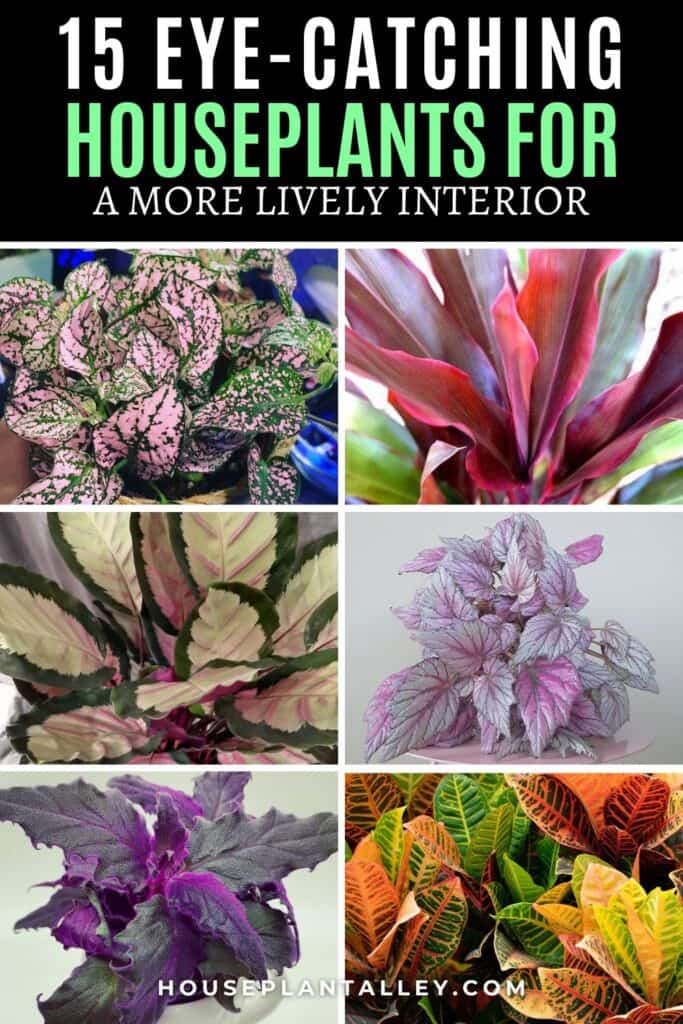
Contents
- 1 1. Purple Passion Plant
- 2 2. Neon Pink Polka Dot Plant
- 3 3. Bright Red Chinese Evergreen
- 4 4. Vibrant Orange Croton
- 5 5. Rainbow Prayer Plant
- 6 6. Lemon-Yellow Peace Lily
- 7 8. Golden Pothos Vine
- 8 9. Dark Purple Persian Shield
- 9 10. Variegated Spider Plant
- 10 11. Begonia Rex
- 11 12. Metallic Silver Nerve Plant
- 12 13. Cordyline fruticosa ‘Rubra’
- 13 14. Royal Purple Wandering Jew
- 14 15. Coleus (Plectranthus scutellarioides)
1. Purple Passion Plant
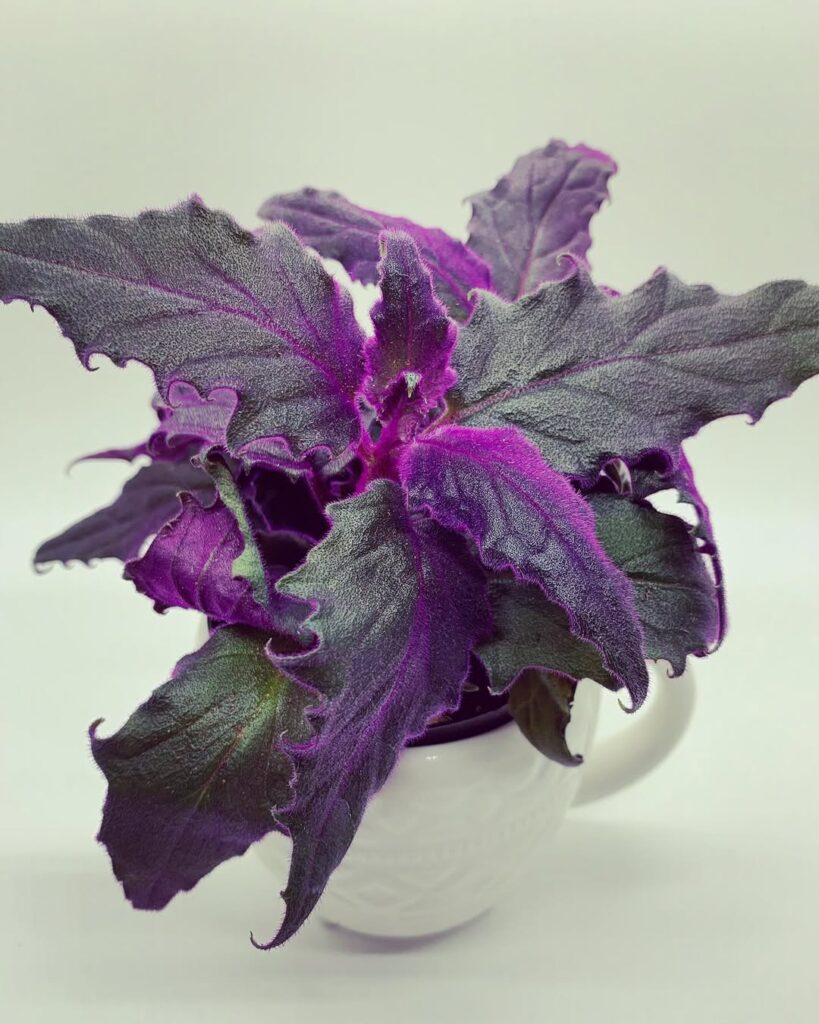
The Purple Passion Plant (Gynura aurantiaca) is a striking houseplant known for its velvety leaves covered in soft, purple hairs that give it a metallic, fuzzy appearance against green foliage. This trailing plant typically grows 1-2 feet tall and features oval-shaped leaves with serrated edges. While it does produce small orange flowers, these are often considered unattractive and emit an unpleasant odor, leading many growers to remove them to maintain the plant’s ornamental foliage appeal.
- Light: Bright, indirect sunlight; protect from harsh afternoon sun
- Water: Keep soil consistently moist but not waterlogged; water when top inch of soil feels dry
- Soil: Well-draining, rich potting mix
- Humidity: Moderate to high humidity (50-60%)
- Temperature: 60-75°F (15-24°C)
- Fertilizer: Feed monthly during growing season with balanced liquid fertilizer
- Pruning: Regular pinching of stem tips to encourage bushier growth
- Container: Pot with drainage holes; can be grown in hanging baskets
2. Neon Pink Polka Dot Plant

The Neon Pink Polka Dot Plant (Hypoestes phyllostachya) is a vibrant, eye-catching houseplant known for its distinctive pink-spotted foliage. This compact plant typically grows 12-18 inches tall and features dark green leaves splashed with bright pink dots, creating a striking pattern that adds a pop of color to any indoor space. Native to Madagascar, this tropical plant is popular among indoor gardeners for its dramatic appearance and relatively easy care requirements.
- Light: Bright, indirect light; avoid direct sunlight which can fade spots; tolerates moderate shade
- Water: Keep soil consistently moist but not waterlogged; water when top inch of soil feels dry
- Soil: Well-draining, rich potting mix with organic matter
- Humidity: Prefers high humidity; mist regularly or use a humidity tray
- Temperature: 65-80°F (18-27°C)
- Fertilizer: Feed monthly with balanced liquid fertilizer during growing season
- Pruning: Pinch back regularly to maintain bushiness and prevent legginess
3. Bright Red Chinese Evergreen
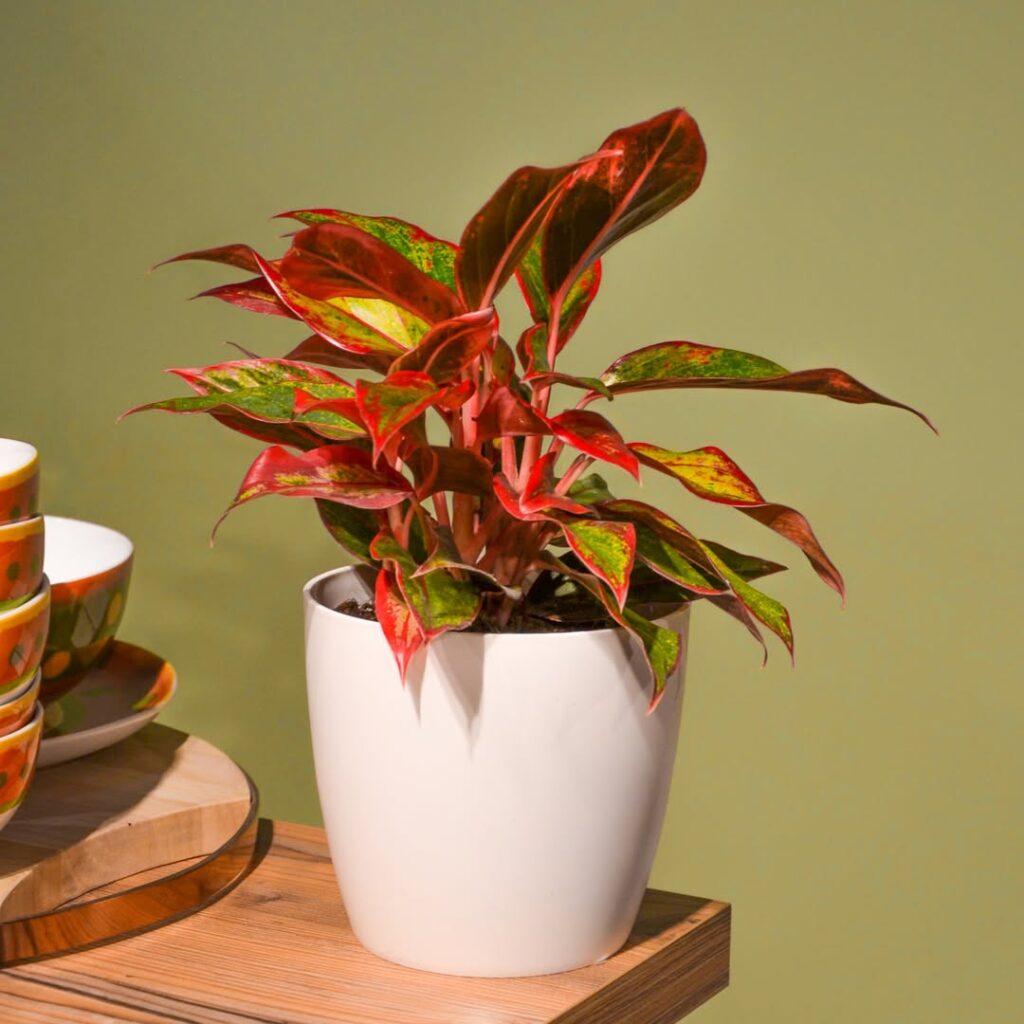
The Bright Red Chinese Evergreen (Aglaonema ‘Red Siam’ or similar cultivars) is a striking tropical houseplant known for its vibrant red-tinged foliage. The leaves feature dramatic patterns of deep crimson, pink, and green coloring, making it a stunning accent piece in any indoor space. This slow-growing, compact plant typically reaches heights of 1-2 feet, maintaining its bold coloration throughout the year while requiring minimal maintenance.
- Light: Moderate to bright indirect light; avoid direct sunlight which can fade the red coloring
- Water: Keep soil consistently moist but not waterlogged; water when top inch of soil feels dry
- Soil: Well-draining potting mix rich in organic matter
- Temperature: 65-80°F (18-27°C)
- Humidity: Moderate to high humidity; mist regularly or use a humidity tray
- Fertilizer: Feed monthly during growing season with balanced liquid fertilizer
- Soil pH: 5.6-6.5
4. Vibrant Orange Croton
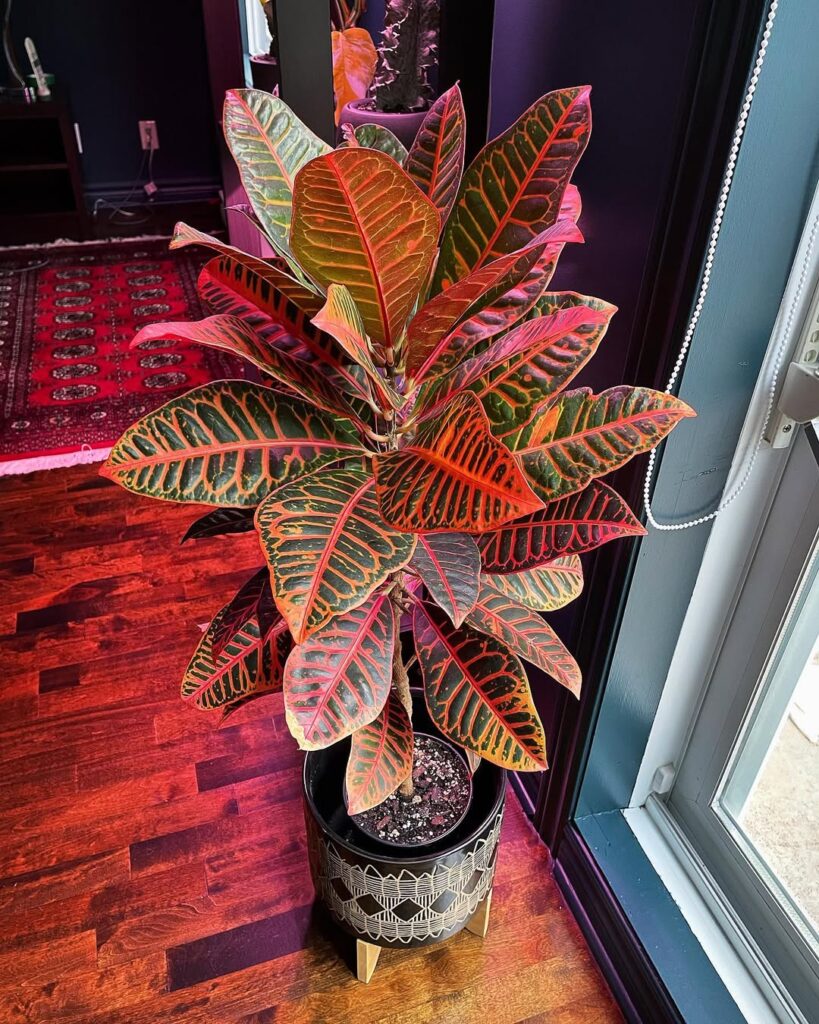
The Vibrant Orange Croton (Codiaeum variegatum) is a tropical plant renowned for its stunning foliage that features a striking mix of orange, yellow, and green hues. The leaves are thick, leathery, and often twisted or curled, with prominent veining that adds to their dramatic appearance. As the plant matures, the colors become more intense, particularly when exposed to bright light, making it an eye-catching centerpiece in any indoor space.
- Light: Bright, indirect sunlight; some direct morning sun can enhance leaf coloration
- Water: Keep soil consistently moist but not waterlogged; water when top inch of soil feels dry
- Soil: Well-draining, rich potting mix with added peat moss
- Humidity: High humidity (60% or higher); regular misting or use of humidity tray recommended
- Temperature: Warm environment between 60-85°F (15-29°C)
- Fertilizer: Monthly feeding during growing season with balanced, water-soluble fertilizer
- Pruning: Occasional trimming to maintain shape and remove damaged leaves
5. Rainbow Prayer Plant
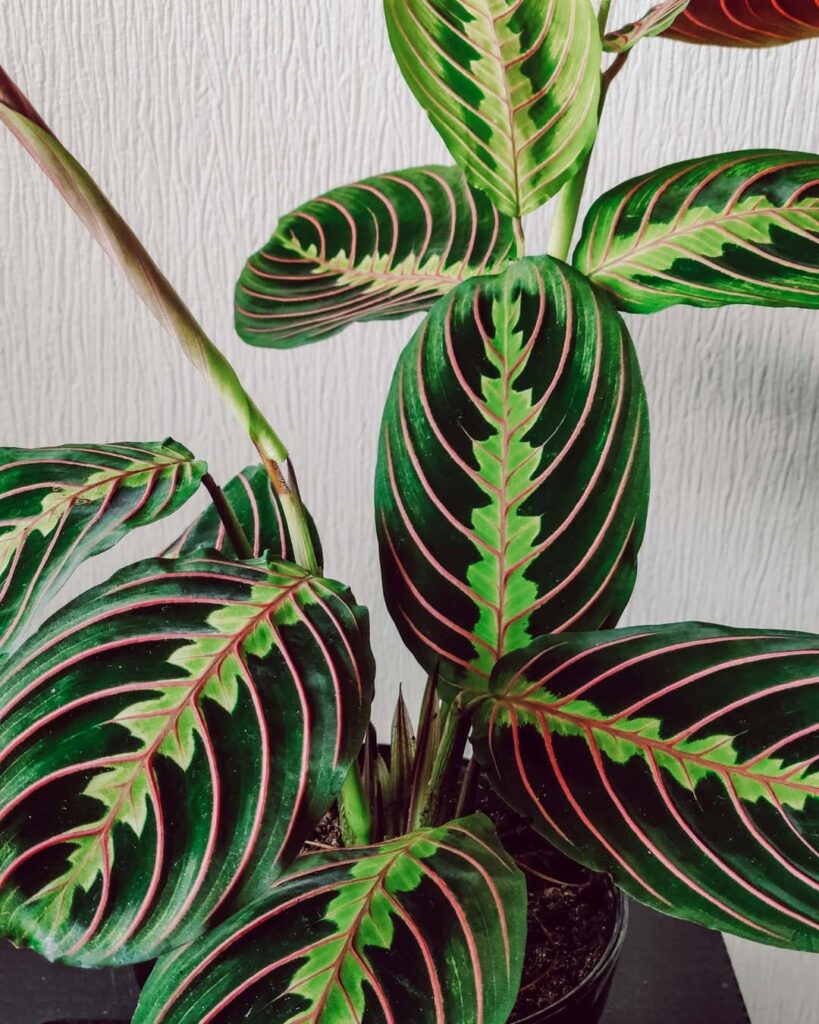
The Rainbow Prayer Plant (Maranta leuconeura) is a striking tropical houseplant known for its vibrant, painted-like foliage featuring patterns of dark green, cream, pink, and red. Its oval leaves display intricate markings along the veins, creating a painterly effect that resembles delicate brushstrokes. This plant gets its common name from its distinctive behavior – the leaves fold upward at night like hands in prayer and lower again during daylight hours, a process called nyctinasty.
- Light: Bright to moderate indirect light; avoid direct sunlight which can fade leaf colors
- Water: Keep soil consistently moist but not waterlogged; water when top inch of soil feels dry
- Humidity: High humidity (60% or higher); regular misting or use of humidity tray recommended
- Temperature: 65-80°F (18-27°C); protect from cold drafts
- Soil: Well-draining, rich potting mix with high organic matter content
- Fertilizer: Feed monthly during growing season with balanced, water-soluble fertilizer
- Propagation: Division or stem cuttings in spring
6. Lemon-Yellow Peace Lily
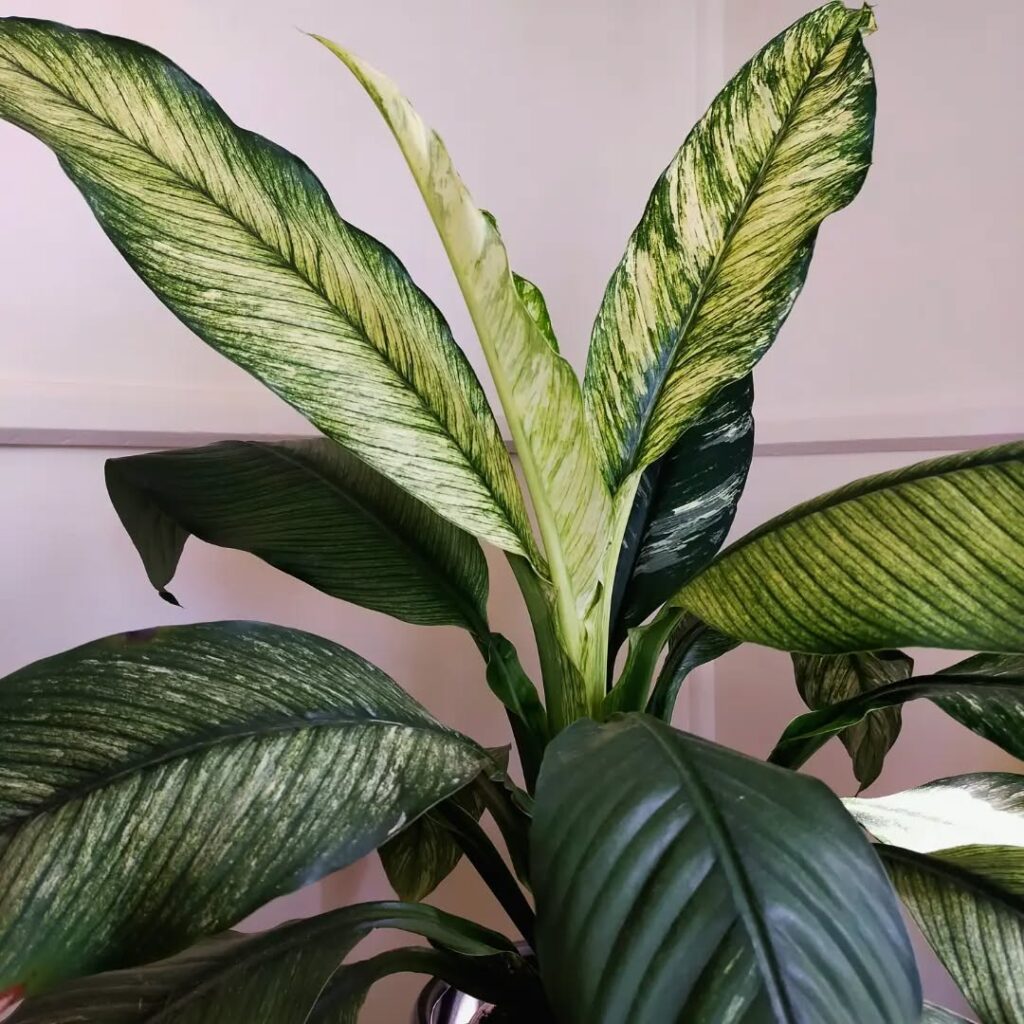
The Lemon-Yellow Peace Lily (Spathiphyllum ‘Sensation’) is a rare and striking variant of the classic peace lily, featuring distinctive yellow-tinged foliage and creamy white flowers. Unlike the standard green peace lily, this variety’s leaves have a subtle lemon-yellow variegation that brightens any indoor space. The plant maintains the same elegant, upright growth pattern and spoon-shaped leaves as its green counterpart, but with this unique coloring that makes it particularly desirable among collectors.
- Light: Bright indirect light; avoid direct sunlight which can burn leaves
- Water: Keep soil consistently moist but not waterlogged; water when top inch of soil feels dry
- Soil: Well-draining, rich potting mix with high organic content
- Humidity: Prefers high humidity (50-60%); mist regularly or use a humidity tray
- Temperature: 65-80°F (18-27°C)
- Fertilizer: Feed monthly during growing season with balanced liquid fertilizer
- Pot Requirements: Container with drainage holes
- Soil pH: 6.0-6.5
8. Golden Pothos Vine
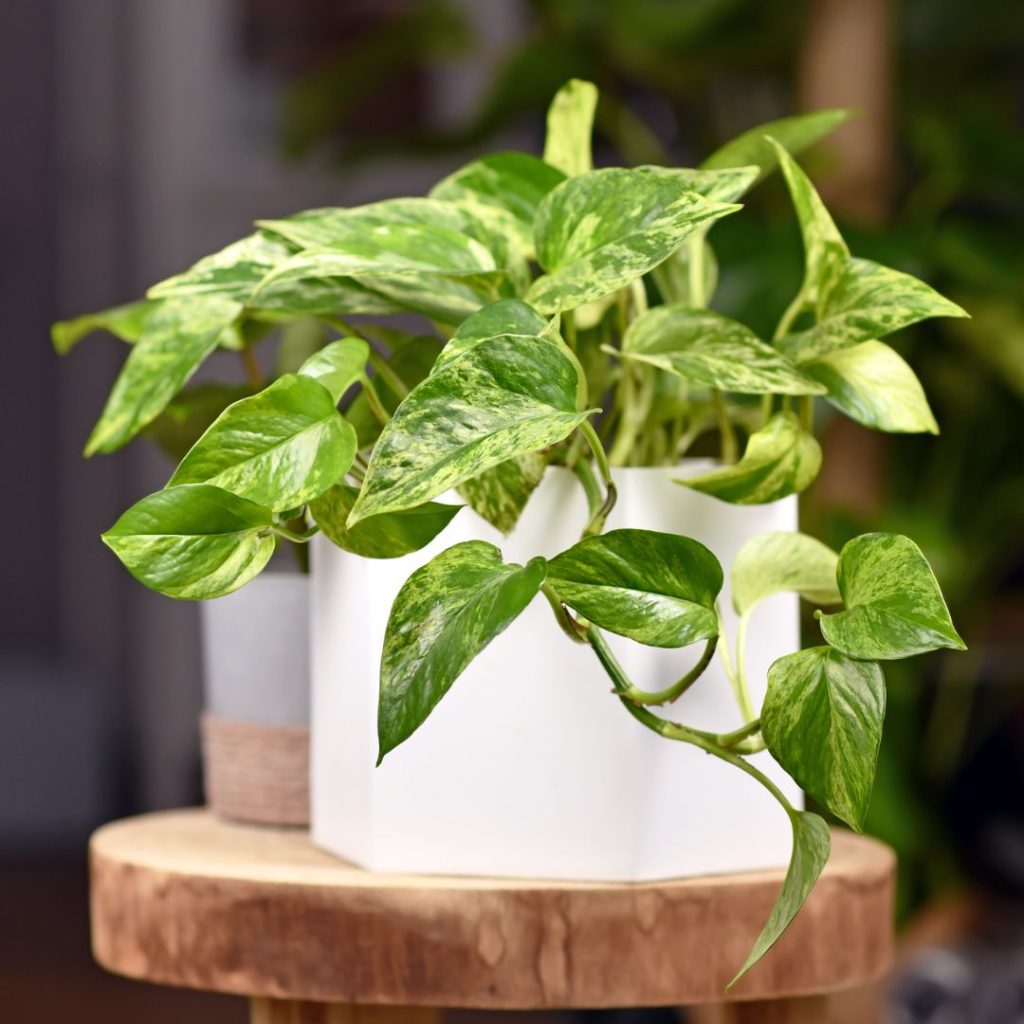
The Golden Pothos (Epipremnum aureum) is a popular trailing houseplant known for its heart-shaped leaves featuring vibrant variegation in yellow and green hues. This easy-growing vine can reach lengths of 20-40 feet in its natural habitat, though it typically stays more compact as a houseplant. Its distinctive marbled patterns make it an attractive choice for hanging baskets, wall climbers, or as a standing plant, while its air-purifying qualities add practical value to its aesthetic appeal.
- Light: Thrives in medium to bright indirect light; can tolerate low light but may lose variegation; avoid direct sunlight
- Water: Allow top 1-2 inches of soil to dry between waterings; water less in winter
- Soil: Well-draining potting mix with good aeration
- Humidity: Adapts to average household humidity; benefits from occasional misting
- Temperature: Comfortable in normal room temperatures between 60-80°F (15-27°C)
- Fertilizer: Feed with balanced liquid fertilizer every 4-6 weeks during growing season
- Pot: Any container with drainage holes; plastic or terracotta both suitable
9. Dark Purple Persian Shield
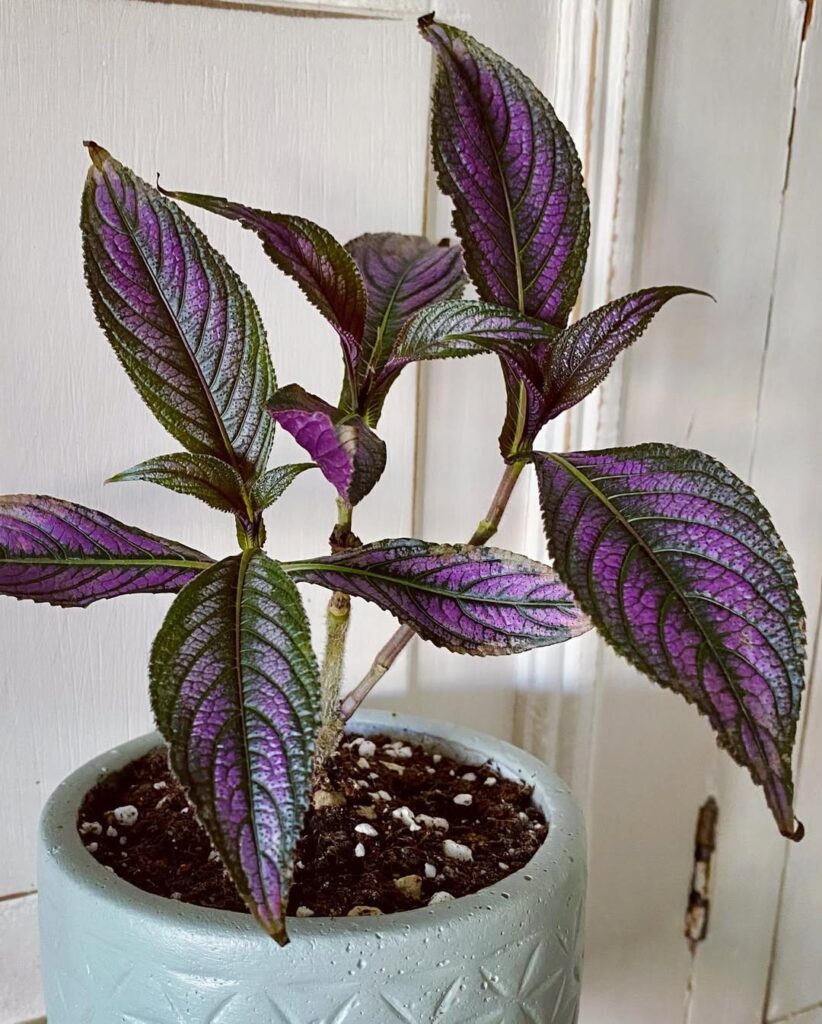
The Persian Shield (Strobilanthes dyerianus) is a striking tropical plant known for its iridescent purple leaves with deep metallic undertones. The dramatic foliage features deep purple hues on the top surface with lighter purple undersides, and silvery-green veining that creates a stunning contrast. This bushy plant can grow up to 4 feet tall and makes an eye-catching addition to both indoor spaces and outdoor gardens in warm climates.
- Light: Bright, indirect sunlight; can tolerate partial shade but needs some light for vibrant colors
- Water: Keep soil consistently moist but not waterlogged; mist regularly to maintain humidity
- Soil: Well-draining, rich potting mix
- Temperature: 60-75°F (15-24°C)
- Humidity: High humidity levels (50% or higher)
- Fertilizer: Feed monthly during growing season with balanced liquid fertilizer
- pH: 5.5-7.5
- USDA Hardiness Zones: 8-11
10. Variegated Spider Plant
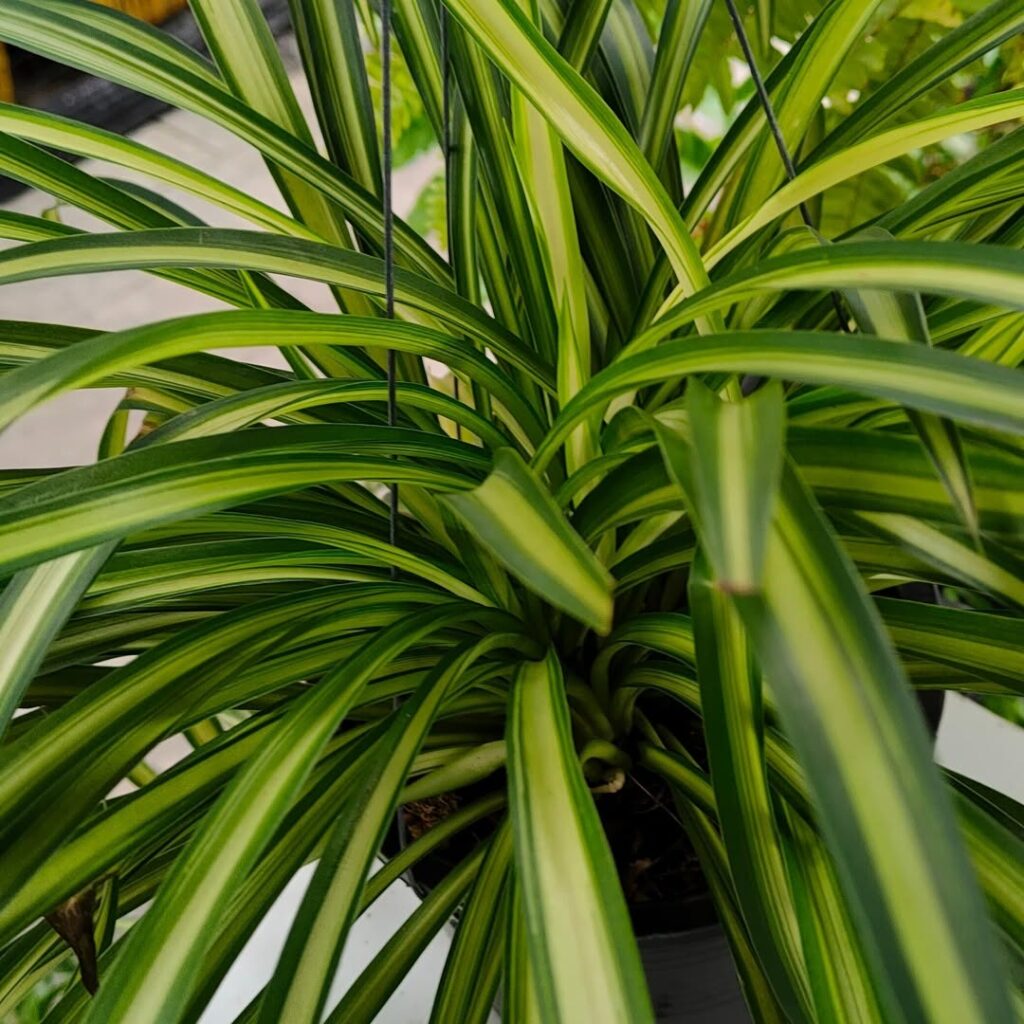
The variegated spider plant (Chlorophytum comosum ‘Vittatum’) is a popular houseplant known for its distinctive arching leaves featuring white stripes along their centers. These graceful plants produce long stems called stolons that dangle downward, bearing small plantlets or “babies” that can be propagated into new plants. The variegated foliage creates an eye-catching display, making it an excellent choice for hanging baskets or elevated containers where its cascading growth habit can be fully appreciated.
- Light: Bright, indirect sunlight; can tolerate moderate light but may lose variegation in low light
- Water: Keep soil consistently moist but not waterlogged; allow top inch of soil to dry between waterings
- Soil: Well-draining, rich potting mix
- Humidity: Tolerates average home humidity levels
- Temperature: 60-75°F (15-24°C)
- Fertilizer: Feed monthly during growing season with balanced liquid fertilizer
- Container: Pot with drainage holes to prevent root rot
- Spacing: Plant can spread 2-3 feet wide when mature
11. Begonia Rex
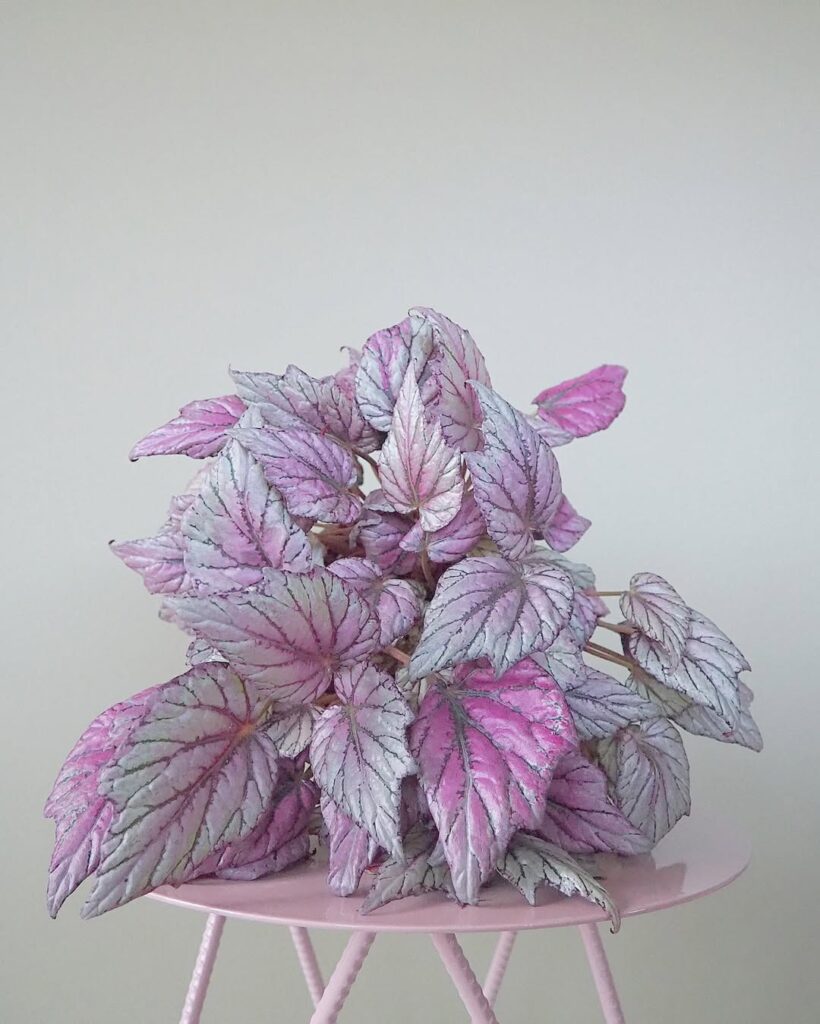
Begonia Rex is one of the most visually stunning indoor plants, prized for its bold, multicolored foliage. Its leaves display swirling patterns of silver, red, purple, and green, making it a true showstopper. This rhizomatous begonia is perfect for adding a touch of dramatic color to any indoor space.
- Light: Bright, indirect light; avoid direct sun to prevent leaf damage
- Water: Keep soil evenly moist but avoid overwatering; water when the top inch feels dry
- Soil: Well-draining, organic-rich potting mix with added peat moss
- Humidity: High humidity (50-70%); benefits from misting or a humidity tray
- Temperature: 60-75°F (16-24°C)
- Fertilizer: Feed monthly with diluted, balanced liquid fertilizer during active growth
- Soil pH: Slightly acidic to neutral (5.5-7.0)
12. Metallic Silver Nerve Plant
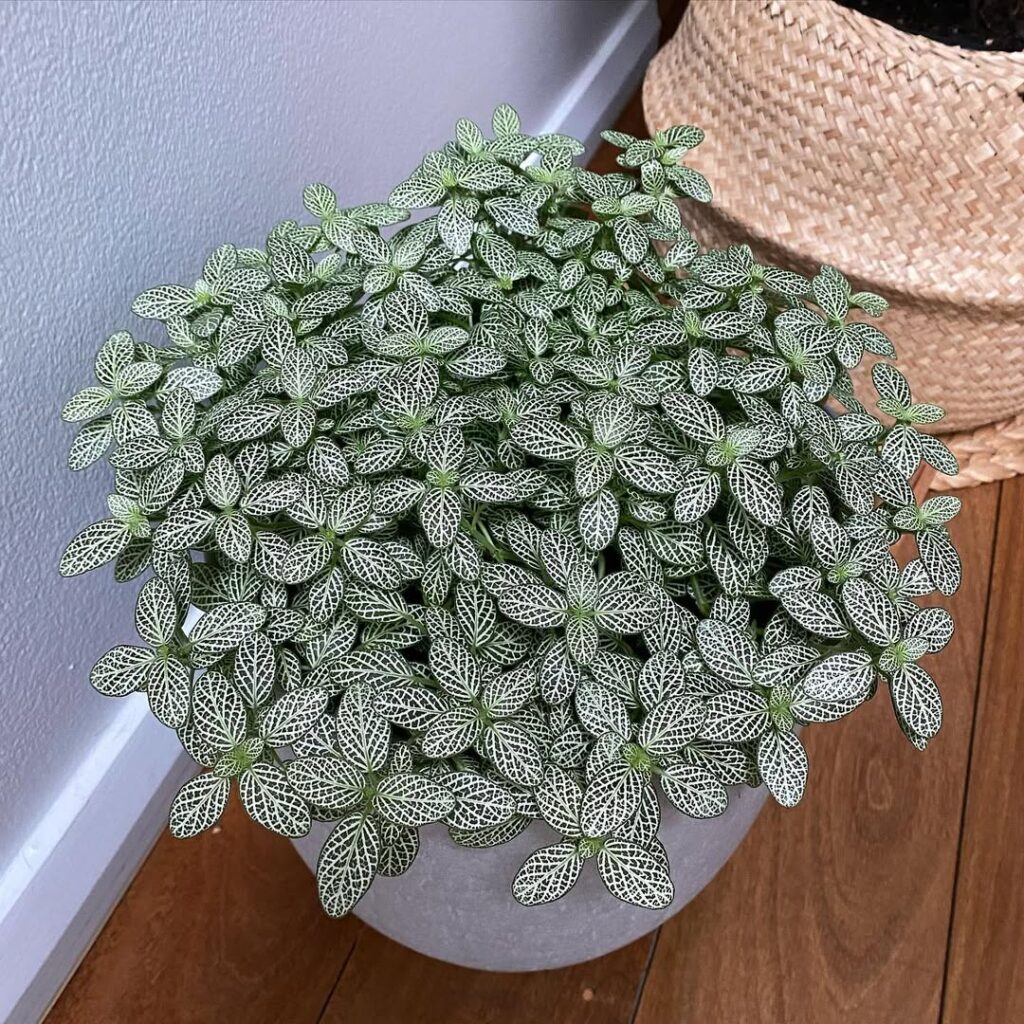
The Metallic Silver Nerve Plant (Fittonia albivenis) is a striking tropical plant known for its distinctive silvery-white veins that create an intricate network pattern against dark green leaves. This low-growing, creeping plant typically reaches heights of 3-6 inches, making it perfect for terrariums, hanging baskets, or as groundcover in indoor arrangements. The metallic sheen of its veins gives it an almost otherworldly appearance, while its compact growth habit and spreading nature make it an excellent choice for adding visual interest to shaded areas.
- Light: Bright indirect light; avoid direct sunlight which can scorch leaves
- Water: Keep soil consistently moist but not waterlogged; prefers high humidity
- Soil: Well-draining, rich potting mix with high organic content
- Temperature: 60-80°F (15-27°C)
- Humidity: Minimum 50%; higher humidity preferred
- Fertilizer: Feed monthly with balanced liquid fertilizer during growing season
- Propagation: Easy to propagate through stem cuttings
- Container: Use pots with drainage holes to prevent root rot
13. Cordyline fruticosa ‘Rubra’
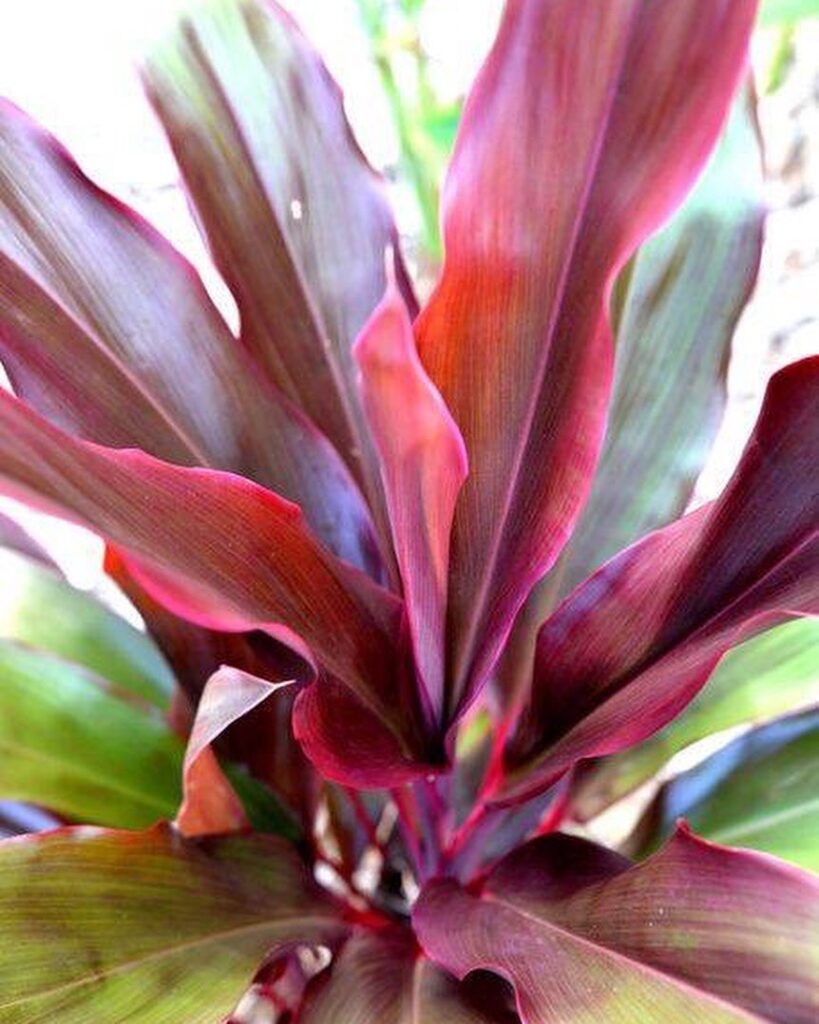
Cordyline fruticosa ‘Rubra’ is a striking tropical foliage plant with bold red and burgundy-hued leaves that create a vibrant display indoors. This variety of Cordyline is valued for its deep ruby-colored foliage, which intensifies in bright light, making it a stunning addition to modern home décor. Its upright growth and glossy leaves add structure and color to any indoor space.
- Light: Bright, indirect light; some direct sunlight enhances red tones
- Water: Keep soil consistently moist but avoid waterlogging
- Temperature: 65-85°F (18-29°C)
- Humidity: High humidity; benefits from misting or a humidity tray
- Growing Medium: Well-draining potting soil with organic matter
- Fertilizer: Feed every 4-6 weeks with balanced liquid fertilizer during the growing season
- Pruning: Trim older leaves to encourage fresh growth
- Propagation: Stem cuttings in water or soil
14. Royal Purple Wandering Jew
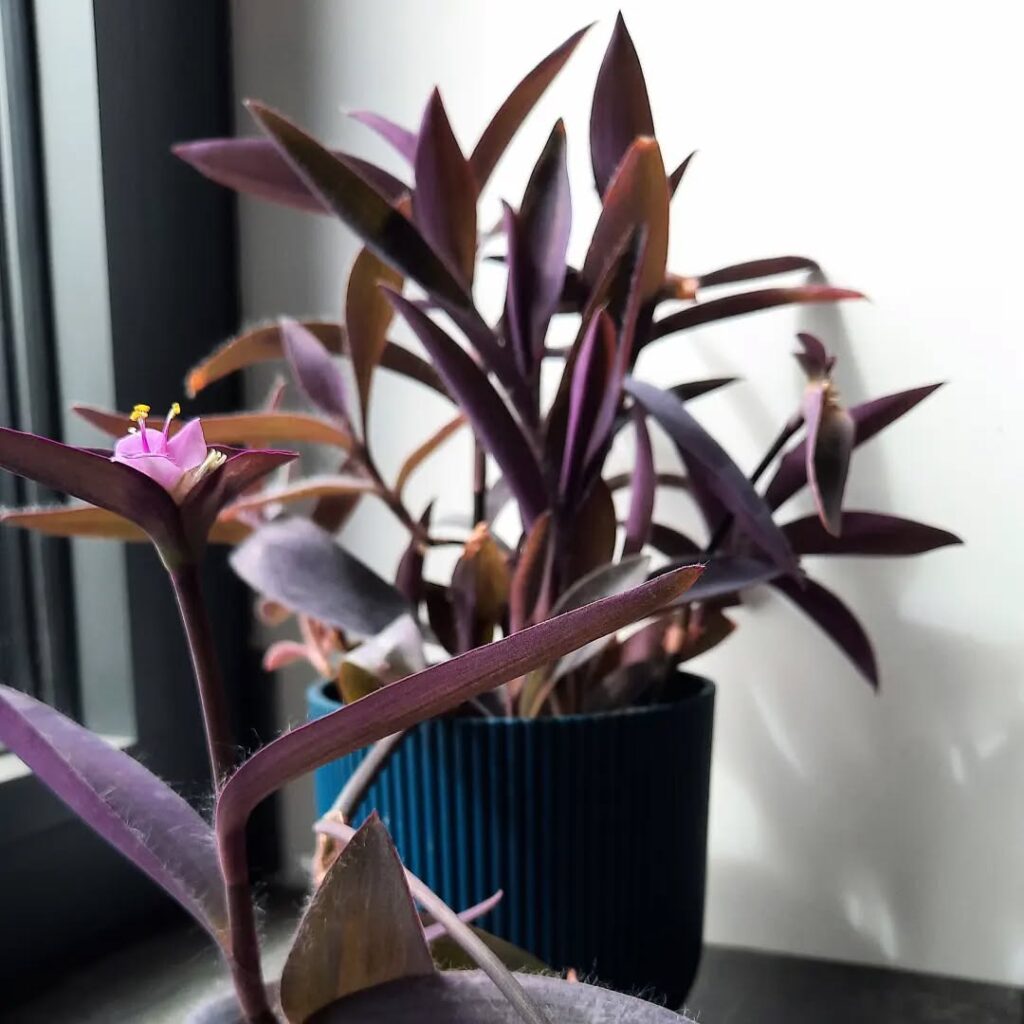
The Royal Purple Wandering Jew (Tradescantia pallida) is a striking trailing plant known for its deep purple foliage and delicate pink flowers. Native to Mexico, this popular houseplant features elongated leaves with a rich, royal purple hue on both sides, creating a dramatic cascading effect when grown in hanging baskets or as ground cover. The succulent-like stems can grow quickly and produce small, three-petaled flowers throughout the growing season.
- Light: Bright, indirect light; can tolerate some direct morning sun but protect from harsh afternoon rays
- Water: Keep soil consistently moist but not waterlogged; water when top inch of soil feels dry
- Soil: Well-draining potting mix rich in organic matter
- Humidity: Moderate to high humidity; mist regularly in dry conditions
- Temperature: 60-80°F (15-27°C); not frost tolerant
- Fertilizer: Feed monthly during growing season with balanced liquid fertilizer
- Pruning: Trim regularly to maintain shape and promote bushier growth
- Propagation: Easily propagated through stem cuttings in water or soil
15. Coleus (Plectranthus scutellarioides)

Coleus is one of the most vibrant foliage plants, featuring striking color combinations of red, pink, green, yellow, and purple. Its serrated edges and intricate variegation make it a standout indoor plant, adding a bold splash of color to any space. With compact, bushy growth and an ability to adapt to various environments, coleus is a favorite for decorative containers and accent planting.
- Light: Bright, indirect light; tolerates partial shade but colors intensify in better lighting
- Water: Keep soil consistently moist but not soggy; allow top inch of soil to dry before watering
- Temperature: 65-85°F (18-29°C)
- Humidity: Moderate to high humidity levels
- Growing Medium: Well-draining potting mix rich in organic matter
- Fertilizer: Monthly feeding with balanced nutrients to maintain vibrant foliage
- Pruning: Pinch back leggy growth to encourage bushiness and prevent excessive stretching
- Propagation: Stem cuttings in moist soil or water until roots develop
